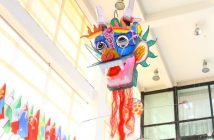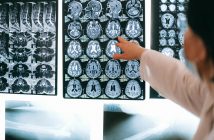 Traditional Chinese Medicine may seem mysterious, if not hokey, to some*, but one area that seems to hold the most weight is acupressure (tui na, 推拿), and its twin discipline, acupuncture (zhen jiu,针灸). Both practices are based on a system of pressure points located along meridians throughout the body, and though there is “no known anatomical or histological basis for the existence of acupuncture points or meridians,” pressure points have been studied extensively to the point that the concept has more or less been accepted by Western medicine (the American Heart Association, for instance, recognizes at least 11 pressure points on the body).
Traditional Chinese Medicine may seem mysterious, if not hokey, to some*, but one area that seems to hold the most weight is acupressure (tui na, 推拿), and its twin discipline, acupuncture (zhen jiu,针灸). Both practices are based on a system of pressure points located along meridians throughout the body, and though there is “no known anatomical or histological basis for the existence of acupuncture points or meridians,” pressure points have been studied extensively to the point that the concept has more or less been accepted by Western medicine (the American Heart Association, for instance, recognizes at least 11 pressure points on the body).
Having a mother versed in Chinese medicine has given me a lifelong affinity to this traditional practice. I was first intrigued when, after a particularly stressful episode in college, my mother offered to stick me with a few needles to soothe my nerves. Utterly frayed, I agreed, and submitted myself for the sticking; though she was still a novice (a few of the points on my head and face took a few painful tries, not to mention drops of blood), we eked out a 20-minute session. At first, I dared not move for fear that a wanton pin would end up engorged in my flesh. But after a few tense minutes, I managed to relax and soon discovered a most peculiar tingling sensation running along my entire body. Far be it from uncomfortable, it proved quite soothing, and when the time came to remove the needles I was practically half asleep. I emerged from the session refreshed, relaxed and utterly chilled out.
A second seminally convincing episode occurred after I moved to Beijing. After an afternoon of swimming at the Friendship Hotel pool, my friends suggested spending the evening getting our feet massaged at the then most popular place in town. Being a first time “virgin,” I imagined a soothing spa-like experience with scented oils and the like – little did I know what lay in store. The first few minutes were fine, but when the freakishly strong masseuse started digging in with her knuckles and digits, I experienced what could only be described as “unprecedented levels of concentrated discomfort.”
But again, like my previous acupuncture episodes, the hurt gradually lessened to a “hurt so good,” and I began quizzing the masseuse on what points corresponded to what organ/body part. It indeed seemed strange that the points pertaining to my most ailing bits (i.e. digestion, vertebrae) not only hurt like hell, but elicited actual physiological reactions – I distinctly felt my stomach grumble each time she pressed on the particular point. What was most astounding, however, was when I asked her to work on the point pertaining to the ear. She dutifully obliged and a stream of water from that afternoon’s swimming session came gushing out. I was not only convinced – I was hooked.
Since then I’ve encountered a gamut of practitioners, ranging from the very good to the utterly bogus (I remain most suspicious of herbal medicinists, many of whom seem to have no idea what toxins their brews contain – my mother actually got very ill one year after ingesting such a concoction). And though my visits to acupuncturists, tui na specialists and reflexologists have been more sporadic in recent years, I still swear by the good ones who have treated me.
A range of self-help Chinese medicine books have been all the rage lately – i.e. Qiu Yi Bu Qiu Ji ( 求医不如求己 – lit. Going to the Doctor doesn’t measure up to Helping Yourself), Ren Ti Shi Yong Shou Ce (人体使用手册 – The User’s Manual for the Human Body) and Cong Tou Dao Jiao Shuo Jian Kang (从头到脚说健康 – Health from Head to Toe) and home “DIY” kits like this “pebble”-covered reflexology mat.
All the books are in Chinese, and I have yet to encounter any English translations, but you can check out this useful site with a nifty interactive diagram of pressure points.
*And I’m not just referring to Westerners here, I’ve met many a Chinese who totally dismiss it as superstition.
Other useful links:
The Beijinger Directory of Foot Massage places
How to apply acupressure
Acupressure Guide
Pointfinder: The Online Acupressure Guide
Interactive Acupressure Guide
And for you dog lovers …



